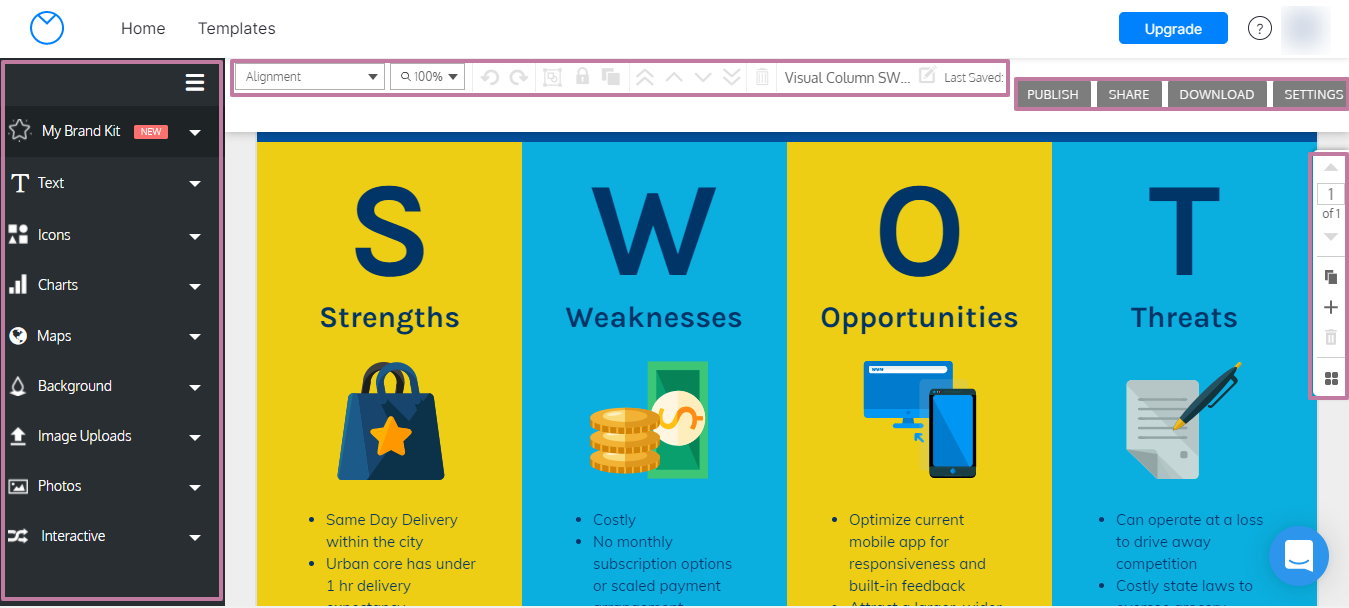
Image source: Unsplash
Without a solid marketing strategy, you’d be hard-pressed to meet your marketing goals.
After all, your marketing strategy provides the framework you need to carry out your plans and focus your efforts to succeed in a fiercely competitive, dynamic market.
However, marketing isn’t a simple, one-off activity.
It includes many moving parts and various critical components across each of your business’s initiatives, making it crucial to understand marketing strategy and its importance.
In this guide, we’ll dive into what a marketing strategy is and why you need one for your business to succeed and grow.
Defining marketing strategy
A marketing strategy is a company’s overall game plan to reach prospective leads and turn them into paying customers.
Essentially, a marketing strategy includes your:
- Key branding message
- Value proposition
- Target customer demographics data
- Other essential components
It combines all aspects of the customer journey, giving you and your marketing, sales, and customer service teams the necessary visibility.
This helps your teams focus your available resources and marketing tactics on generating the most conversions and sales and boosting your competitive advantage.

A comprehensive marketing strategy includes the four Ps of marketing: Price, product, promotion, and place.
While a marketing strategy can vary depending on the unique business needs and goals, it should communicate to your customers what your brand stands for, how it operates, and why prospects should buy from you.
It provides a template that informs your marketing initiatives across your company’s products and services.
Why do you need a solid marketing strategy?
Besides giving your teams a framework to guide your marketing initiatives’ implementation, a marketing strategy serves as a scalable and repeatable template.
While your marketing strategy might need some tweaks and regular adjustments, it provides a blueprint that makes spotting similar or improved results from each campaign easier without reinventing the wheel.
As such, your marketing strategy can give your team a sense of predictability and stability since it allows you to repeat successful processes and anticipate the results.
Additionally, a solid marketing strategy gives you the necessary information to plan your resource allocation, tools, and initiatives to implement your campaigns effectively.
For instance, if you own a car dealership, part of your overall marketing strategy would be to get dealership marketing support from a reliable service provider and platform.
Essential components of a marketing strategy
Building (or refining) a marketing strategy takes more than listing down the things you want to achieve from your marketing efforts and the potential results.
You’ll need to focus on several crucial marketing strategy components to implement your marketing initiatives properly.
1. Goals and objectives
Goals are the broad and overarching things that you want to achieve long-term. Your objectives refer to the more precise, specific action (or actions) you take to meet your overall goals.
One of the best ways to determine your goals and objectives is to adopt the SWOT marketing analysis method to identify your marketing weaknesses, strengths, threats, and opportunities.
This can give you a clear view of where you succeed and areas for improvement, helping you implement the right tactics and adjustments to tackle challenges and make the most of your opportunities.
Use tools such as Venngage to create your SWOT analysis from a template and present (or share) it easily with your marketing team.

You can use the editing tools to add icons, images, texts, backgrounds, and other elements to create a comprehensive SWOT analysis.
Performing a marketing SWOT analysis allows you to dive deep into your company, including the broader market environment, to determine your actionable and measurable objectives and goals.
2. Target audience
Not everyone is interested in your offers and products. This makes it crucial to determine your target audience or the group of people most likely to identify with your brand and buy your services and products.
An excellent way to identify, re-establish, and redefine your target audience is through segmentation.
The four main market segmentation types are:
- Demographics – Gender, age, marital status, and income (among others)
- Geographic – Urbanicity, language, location, culture, and climate
- Psychographic – Likes, dislikes, opinions, values, and lifestyle
- Behavioral – User actions on your website, in-store, and in-app
You can gather your data for these audience segments through interviews, social media analytics tools, in-app and web user actions analyses, and online surveys.
Use tools such as Typeform, software for online form building that lets you create surveys quickly.
You can select a template and use the software’s add form elements, choose a layout, include buttons, texts, and images, and customize the design as you prefer.

Once you have all the data you need to segment your prospects, build or refine your buyer personas to establish a structure to your audience targeting efforts.
Creating (or refining) your market segmentation and buyer personas allow you to better learn about your prospective customers.
This helps you tailor your marketing content and efforts to address your target audience’s pain points, align your resources, and optimize your product development.
In a nutshell, knowing your target audience helps you deliver the right marketing content, message, and offer to the right people at the best time to increase your conversions and sales.
3. Competitor analysis
Having a clear idea of where you stand in the market compared to your competitors is crucial to get a benchmark to measure your company’s growth.
This is where performing competitor analysis comes in handy.
Competitor analysis helps you uncover and understand your biggest competitors, their social media presence, website, and sales, products, and marketing strategies (among others).
The more you understand your competitors, the better you can identify opportunities and areas to overtake and outperform them, giving your business a competitive advantage.
You’ll also get ideas about the kind of marketing initiatives that work (and don’t work) in your industry and target market.
Leverage reliable competitor research and analysis software to help you gain valuable insights easily.
You can use the analytics data to discover your competitors’ successful marketing initiatives and use them to develop your own as part of your marketing strategy.
This also helps you identify and project the qualities that make your brand unique and build critical aspects of your marketing strategy around those.
Start developing a killer marketing strategy for your business
A well-planned and developed marketing strategy will help you achieve your short and long-term marketing and overall business goals.
While building your marketing strategy and implementing it can take some elbow grease, having a solid framework from the get-go allows you to focus and optimize your resources, budget, and efforts.
With a solid marketing strategy in place, boosting customer loyalty, increasing your returns and sales, gaining competitive advantage, and strengthening your brand becomes more obtainable and efficient.
